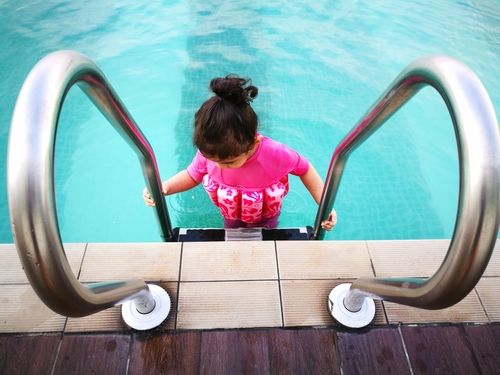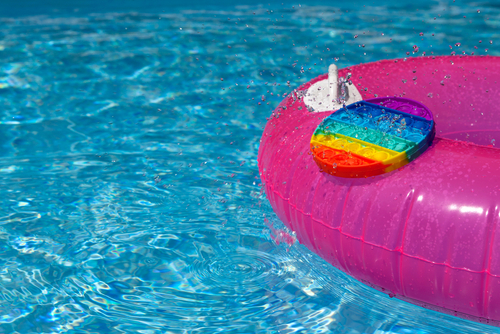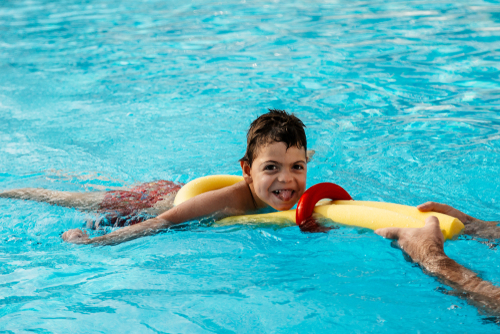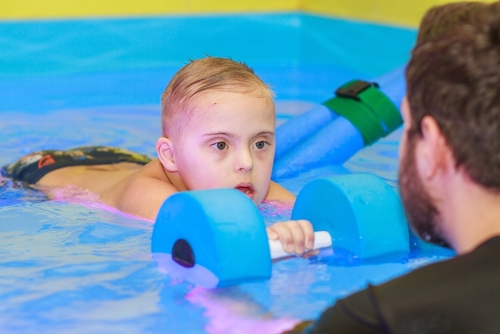Warmer weather has arrived. Many families, including those within the disability community, are looking forward to plunging into aquatic pastimes. Whether you want to leisurely float around the pool or make a big splash at an accessible waterpark, it’s important be mindful of water safety. That’s because, according to the Children’s Safety Network, drowning is the leading cause of unintentional injury deaths for children ages 1-4 and the third leading cause of unintentional injury deaths for children ages 5-19. Furthermore, some children with disabilities have a greater risk of drowning, such as those with autism spectrum disorder (ASD), Down syndrome, heart disease and seizure disorders (like epilepsy).
“Among parents who have lost a child to drowning, the most common response I hear is ‘we didn’t know’ – didn’t know how prevalent it is, didn’t know how easily it can happen and didn’t know that one strategy for prevention just isn’t enough,” says Adam Katchmarchi, Ph.D., Executive Director of the National Drowning Prevention Alliance (NDPA).
The Autism Society reports that children with ASD are 160 times more likely to experience nonfatal or fatal drowning compared to their neurotypical peers. As alarming as that is, children with disabilities (and their typical peers) can absolutely enjoy water activities when safety precautions are taken.
Five Layers of Protection to Curb Risk of Drowning
“There are so many misperceptions about drowning, particularly as it relates to children,” says Katchmarchi. “Perhaps the most important to dispel is the myth that one strategy for prevention is enough. This summer, we want to change that by putting information and resources on the need for five layers of protection directly into the hands of parents and communities.”

NDPA is encouraging parents and caregivers to employ “Five Layers of Protection” whenever a child, with or without disabilities, is near open water to prevent drowning. The following are basics outlined by NDPA, paired with additional insight provided by other agencies.
(1) Barriers and Alarms – to help children and unauthorized adults from accessing water unsupervised.
Pools should have complete four-sided isolation fencing with a self-locking gate. Fencing could prevent 50–90% of child-related drowning events, according to the U.S. Swim School Association. Never leave toys in the pool area as it can attract the attention of a curious kiddo, and especially children with ASD who are prone to wandering.
(2) Supervision – close, constant and capable adult supervision by a designated water watcher or lifeguard anytime children are in or around water.
Unlike the loud splashing and screaming scenes depicted in movies, drowning is surprisingly silent. In fact, 9-out-of-10 drowning deaths happen when a caregiver is present but becomes distracted or is not attentive. Drowning can happen quickly – statistics show that 77 percent of home drowning accidents happened after the victim had been missing for no more than five minutes before being found in the swimming pool.
(3) Water Competency – equipping every child with basic water safety skills to reduce the risk of drowning and aquatic-related injuries.
Formal swim lessons (between the ages of one and four) have been shown to reduce the risk of drowning by 88%. Private or small group lessons may be preferrable for those with ASD to limit over-stimulation. The Autism Society suggests that children familiarize themselves with equipment that could potentially irritate senses, like goggles, flippers, caps, lifeguard whistles, etc.
“We strongly encourage swim lessons as early as possible for children with autism and disabilities. Caregivers should discuss when to start swim lessons with their pediatrician,” Katchmarchi tells AmerDisability. He adds, “If financial challenges are a concern, reach out to local nonprofits, swim providers and similar organizations as they can often provide financial assistance to families in need.”
(4) Life Jackets (tested and approved by the U.S. Coast Guard) – to provide protection when you are not expecting to be in the water.
The U.S. Swim School Association notes that blow rafts, rings, water wings and floats are NOT safety devices. They have no safety requirements and can fail. In fact, they can lead parents to have a false sense of security which can increase risk of drowning.
And while the color blue is typically associated with autism awareness and acceptance, a viral TikTok video posted by Nikki Scarnati, a certified Infant Swimming Resource (ISR) instructor, asserts that children, and perhaps especially those with a greater risk of drowning, never wear blue-colored swimsuits. Blending into the water, it can be difficult to see children swimming under the water’s surface when wearing blue. She urges parents to opt for brighter hues and/or neon.
(5) Emergency Response Preparedness – including CPR training, basic water rescue skills and having a phone available and ready to call 911.
Additionally, beachgoers should explain to children the risk of waves, rip tides and other ocean dangers. Plus, aside from drowning, parents and caregivers should communicate swim rules pertaining to jumping, diving or other risky horseplay to eliminate the danger of broken bones, traumatic head injury, paralysis and unintentional accidents.

Watering Down the Risk of Drowning
Dr. Julie Gilchrist, a pediatrician and researcher who also serves as Chief Medical Advisor to the NDPA, shares, “In case after case, we hear stories from families who were diligent in supervising their child while in the pool but didn’t know the many ways drowning can happen – for example, during non-swim times.”
A study published in Injury Epidemiology concluded that “fatal drowning in children with ASD typically occur in water bodies near the victims’ homes in the afternoon hours precipitated by wandering.” Wandering is common and oftentimes hazardous among kids with autism who may not sense danger as easily. They may get fixated on exploring something interesting and/or seek sensory engagement, such as from a body of water.
That’s why the U.S. Swim School Association advises parents with children to regularly conduct a home water safety audit to determine where risks are and what steps to take to enhance protection. Here are some tips:
- Create a list of rooms/spaces (including garages, sheds, front/backyards and other property structures) to survey.
- Identify common risk factors including buckets, toilets, ice chests/coolers, pools/hot tubs, ditches, post holes, wells, etc.
- Locate unique risks, for example: kitchen – a sink filled with soaking dishes; laundry room – utility basin containing residual cleaning water; backyard – displaced buckets that may collect rainwater; bathroom – standing water resulting from faulty drains or leaks; or yard – decorative fountains.
- Fill your bathtub with the amount normally used for bathing and use a stopwatch to time how long it takes to drain. Never leave the bathroom unsupervised after a bath until that time has elapsed.
- Proactively combat prospective risks with toilet lid locks, pool fences and other safety features. Remind yourself to change habits; for example, post a note beside the sink to curb overnight dish soaking. Aside from a pool fence, consider similar landscape barriers surrounding fountains, fishponds or ditches.
- Correct existing safety threats by repairing drains, properly storing buckets/containers (upside down to limit water collection) and play pools, etc.
- Learn emergency lifesaving skills, including first aid and CPR.

Katchmarchi optimistically tells AmeriDisability, “I always like to reinforce that drowning is completely preventable if all layers of protection are followed.”
There’s a lot of information to unpack here and precautions to be made. But, again, water activities can be amazing and accessible. There are many great benefits too. Swimming and/or aquatic activities can build muscle and flexibility, improve motor skills and coordination, support heart and lung health, aid mental wellbeing and reduce pain, among other benefits. So suit up and take the plunge – but please do so safely.






